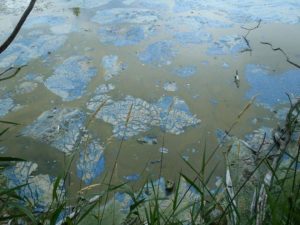Recreational Water Advisory Lifted: Lake Cornelia
UPDATE: WATER ADVISORY LIFTED
September 29, 2017
The water advisory issued on August 17, 2017, affecting Lake Cornelia has been lifted. Water quality samples collected on August 7, 2017, and subsequent dates showed cyanotoxin, a toxin produced by cyanobacteria (also referred to as blue-green algae), detected at levels above the public health advisory threshold. Results from water quality sampling done on September 6, 2017, show that cyanotoxin levels are below advisory levels. Residents may resume recreating at Lake Cornelia.
September 5, 2017

Testing results continue to show that there should be no contact with the water in North Lake Cornelia. The water at North Lake Cornelia contains algal toxins above the public health threshold. Algal toxin levels have decreased since the last lab test, but you should continue to not have contact with the water, algae, or scum or allow your pets to have contact with the water, algae or scum. The toxin that continues to be present in the lake is a neurotoxin that causes strong salivation, cramps, tremor, diarrhea, and vomiting. If you begin to notice symptoms in you or another person, contact your health care provider; in animals, contact your veterinarian.
We will post information updated information when the cyanotoxin levels are below the public health threshold, the Advisory is lifted or if there are any changes to the conditions of the lake.
August 17, 2017
WARNING—Contact with water in North Lake Cornelia might cause illness in humans and pets. The water at North Lake Cornelia contains cyanotoxins from cyanobacteria (blue green algae) at levels that could cause harm. Do not have contact with the water, algae, or scum or allow your pets to have contact with the water, algae or scum.
Testing results have confirmed that algal toxin levels in North Cornelia are above the public health threshold. We will post information updated information when the cyanotoxin levels are below the public health threshold, the Advisory is lifted or if there are any changes to the conditions of the lake.
For more information on cyanobacteria (blue-green algae) and cyanotoxins, see:
FREQUENTLY ASKED QUESTIONS
WHAT ARE CYANOBACTERIAL BLOOMS AND CYANOTOXINS?
Cyanobacteria, also referred to as blue-green algae, are found naturally in lakes, rivers, ponds and other surface waters. They can flourish and quickly multiply to form cyanobacterial blooms, or harmful algal blooms (HABs), especially in the presence of excess nutrients, sunlight, and warmer water temperatures. These blooms can last several weeks or longer and are considered harmful since they are capable of producing toxins, called cyanotoxins, which can harm humans and animals.
WHAT ARE THE HEALTH EFFECTS FROM CYANOTOXINS?
Cyanobacteria and cyanotoxins have been shown to cause acute inflammatory effects or illnesses. Exposure to cyanobacterial cells while in recreational waters may cause skin irritations, including rashes, hives, swelling or skin blisters. Ingestion of cyanotoxins can also cause more severe health effects such as liver or kidney damage, depending on the cyanotoxin and the magnitude, duration and frequency of the exposure. For example, short-term exposures to microcystins could cause liver damage, while kidney damage is a key health effect for cylindrospermopsin. Health effects from cyanotoxin exposure in pets, wildlife, and livestock can include vomiting, diarrhea, seizures, and death.
HOW DOES CYANOTOXIN EXPOSURE OCCUR?
Exposure to cyanobacteria and their toxins may occur by accidental ingestion or inhalation of toxin-contaminated water, or dermal contact during recreational activities (for example, swimming, waterskiing, or tubing). Animals such as pets, livestock, and wildlife may also be exposed to cyanotoxins if they drink water from toxin-contaminated water bodies, lick their fur after swimming in such waters, or consume toxin-containing algal scum or mats.
IS ANY CYANOBACTERIAL BLOOM POTENTIALLY DANGEROUS?
Yes. Any cyanobacterial bloom may potentially cause harm, and it is difficult to tell by looking at a bloom if it is producing toxins. To determine if the bloom is producing toxins, it needs to be tested by trained personnel.
WHAT TYPES OF ALGAE ARE ASSOCIATED WITH TOXINS?
Cyanobacteria (also known as blue-green algae), are photosynthetic bacteria that are capable of producing toxins.
